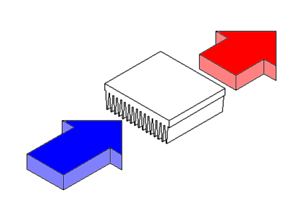How to measure the thermal impedance of a heatsink (1)
Astronomy
Equatorial Table
Hydraulic Focussing
Stepper Motor
How To Make A Telescope
Information for Beginners
Links And Bibliography
Gastronomy
Recipe Schematics
Recipes
To Bake A Well-Risen Cake
Links
Photography
Astronomy
Architecture
Animals
Landscape
Crafts
Livroscope
Read Html Books On Screen
High Rise Handlebars Bike
Dominoes
Power Electronics
Heatsink Impedance
Chess

http://queribus.free.fr
Thermal model
Let us modelize the thermal
behaviour of a component on a heatsink by an electric diagram where
current is replaced with thermal power (P), voltage with
temperature (T) and electrical impedance with thermal impedance (Zth).
To calculate Tj, the junction temperature (temperature of silicon PN junction), let us split impedance in 3 elements:
 Zthjc: between junction and component case
Zthjc: between junction and component case Zthch: between case and heatsink (thermal grease)
Zthch: between case and heatsink (thermal grease) Zthha: between heatink and ambiant air
Zthha: between heatink and ambiant airZthjc and Zthch are given by
the component manufacturer. We want to measure Zthha. Uncertainty on
Zthjc and Zthch does not modify the precision of our measurement.
Cooling
The thermal impedance of the heatisink is a mathematical model that is used to calculate junction temperature Tj.
It is defined for determined conditions outside which the model is not
valid anymore. One of these conditions is the cooling type:
 Natural air cooling: the fins of the heatisink are placed in vertical position.
Natural air cooling: the fins of the heatisink are placed in vertical position.
 Forced air cooling: the speed of air in fins is determined by the fan.
Forced air cooling: the speed of air in fins is determined by the fan. Blowing along fins: makes air flux control easier in an enclosure.
Blowing along fins: makes air flux control easier in an enclosure. Blowing across fins: turbulence is more important and improves heat exchange. Used in computers.
Blowing across fins: turbulence is more important and improves heat exchange. Used in computers.
 Water cooling: water flow also influences thermal impedance. In that case, the heatink in a plate with pipes inside.
Water cooling: water flow also influences thermal impedance. In that case, the heatink in a plate with pipes inside.
Thermal measurements have to be associated with a precise description of cooling conditions:
 Type of fan or air flow speed.
Type of fan or air flow speed.
 Blowing type: along or across fins.
Blowing type: along or across fins.
 Water flow in case of a water plate.
Water flow in case of a water plate.
 Type of fan or air flow speed.
Type of fan or air flow speed. Blowing type: along or across fins.
Blowing type: along or across fins. Water flow in case of a water plate.
Water flow in case of a water plate.


Forced air cooling, air flux across fins